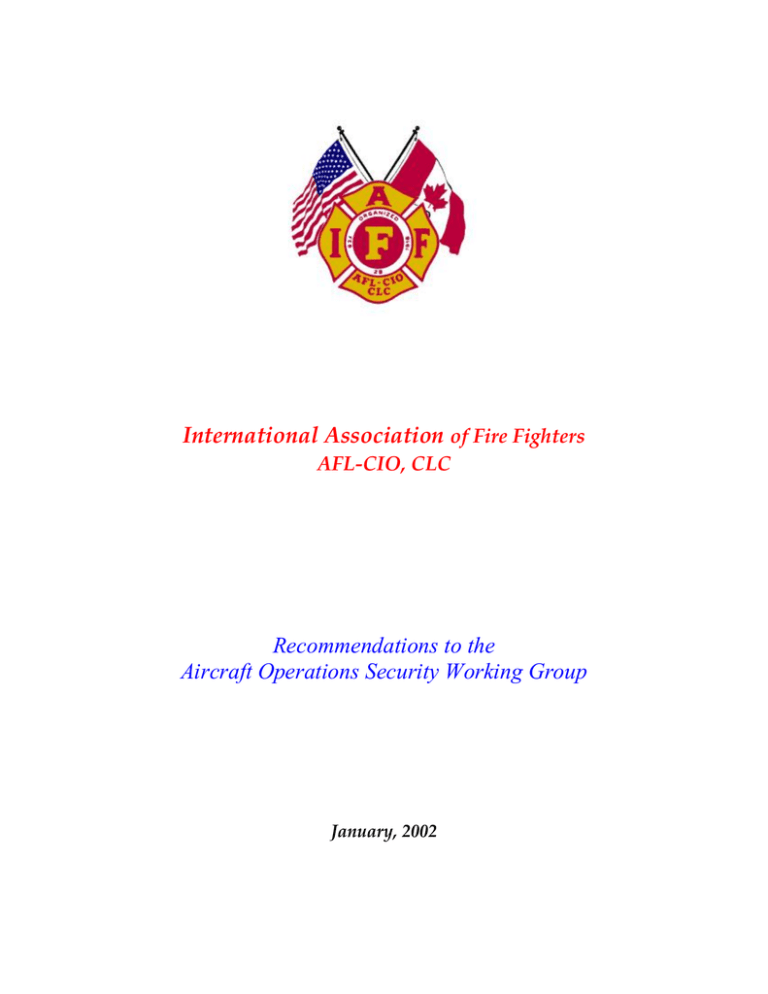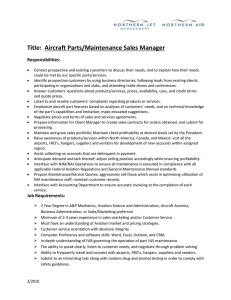International Association of Fire Fighters
advertisement

International Association of Fire Fighters AFL-CIO, CLC Recommendations to the Aircraft Operations Security Working Group January, 2002 International Association of Fire Fighters Recommendations to Aircraft Operations Security Working Group Introduction The International Association of Fire Fighters (IAFF), which represents 17,000 professional fire fighters and emergency medical personnel in Canada, appreciates the opportunity to provide input in the critically-important area of aviation security through the Aviation Security Advisory Committee and the Aircraft Operations Security Working Group. As a representative of airside personnel at designated airports across Canada and emergency personnel who respond to incidents at many other airports, the IAFF is uniquely positioned to offer its expertise involving aircraft security to the flying public through this consultative process. No one disagrees that a new global reality was born in the wake of the horrific events of September 11. No single industry or service was impacted by these events more than the aviation industry. As vulnerabilities have been highlighted by these tragic events, it is incumbent on all of those involved in the industry to work together like never before to mitigate these new threats as much as possible. Aviation is by definition a public service, and the flying public in Canada deserves no less than 100 per cent protection when using commercial aircraft. Enhancing Aviation Security: the Need for Contingencies The Airport Operations Security Working Group, working under the new Aviation Security Advisory Committee, has heard some excellent suggestions from industry and labour regarding ways to prevent the circumstances that allowed terrorists to gain control of four commercial aircraft on September 11 from happening again. While the IAFF supports any recommendation that will ultimately result in the prevention of a terrorist incident involving a commercial aircraft, we strongly assert that contingencies, should those measures fail, must also be examined. To this point, there has been no discussion of contingencies in the consultative process. In that regard, an extremely valuable and critically-important protection that should be afforded the flying public is at serious risk of being overlooked. If the purpose of the consultative process is to save lives, then the process is incomplete if contingencies are not closely examined as part of the entire process of protecting passengers from gate to gate. A good analogy can be drawn in the fact that the National Security Committee is actively examining ways of not only preventing terrorist acts on Canadian soil, but is also 2 exploring ways of limiting, or “mitigating” the aftermath of those attacks should they occur, specifically through the examination of emergency response capabilities. Specifically, the question must be asked, and answered, “What are the response capabilities in place in the event that a hijacked or sabotaged airplane crashes in Canada?” Recommendation #1 The IAFF recommends that the issue of contingency be included in the scope of the Aircraft Operations Security Group and in general added to the debate of aircraft security in response to the events of September 11, 2001. Aircraft Rescue: Critical to Survival According to the Boeing Commercial Airplane Group, Statistical Summary of Commercial Jet Airplane Accidents Worldwide Operations 1959-1996, an astonishing 79.9 per cent of aircraft accidents occur during takeoff, initial climb, initial approach and landing. Despite this fact, the provisions for Aircraft Rescue and Fire Fighting (ARFF) contained in the Canadian Aviation Regulations (CARs) fall short of international standards set by such bodies as the International Civil Aviation Organization (ICAO) and the National Fire Protection Association (NFPA). This is clearly an area of vulnerability in the event that an aircraft, whether in the control of an unauthorized person or group, or as the result of a malicious explosion or other catastrophic terrorism-related event, crashes during or shortly after takeoff or approach. Unlike equivalent standards under ICAO and NFPA, CAR 303 does not specify interior fire suppression and the rescue of trapped passengers as specified and resourced functions of aircraft fire fighters. As a result, airport operators in Canada are not specifically required to provide the resources necessary to enable airport fire fighters to accomplish these lifesaving tasks. ICAO recommends that ARFF standards encompass rescuing victims. ICAO states: The principle objective of a rescue and fire fighting service is to save lives. This must assume at all times the possibility of, and need for, extinguishing a fire which may occur either immediately following an aircraft accident or incident, or at any time during rescue operations. NFPA 402 recommends that aircraft fire fighters enter the cabin and initiate interior fire suppression and the rescue of trapped passengers after those who have been able to selfevacuate have done so. Further, U.S. Department of Defense (DOD) 6055.6 states that each military airport is required to have a dedicated rescue team comprised of trained fire fighters whose mission includes specific aircraft rescue tasks. 3 CAR 303’s version of aircraft rescue assumes that airline personnel, who have just been in an aircraft accident themselves, will perform task of rescuing trapped passengers. All that aircraft fire fighters are required to do, according to CAR 303, is hose down a path through thousands of gallons of burning jet fuel in the hope that passengers will be able to stroll off the plane to safety. Recommendation # 2 The IAFF recommends that Canada’s Aviation Regulations be amended immediately to specify interior fire suppression and the rescue of trapped passengers as resourced functions of aircraft fire fighters. Response Times: the Three Minute Rule In addition, ICAO and the NFPA specify initial response capability to a downed aircraft, to all points on all runways, in less than three minutes of the alarm. It is at the threeminute mark that temperatures inside the fuselage of a downed craft reach a lethal 982 degrees Celsius. ICAO 9.2.19 and 9.2.20 and NFPA 403 specify first apparatus response capability to any point on the operational runways, as well as any other part of the movement area, of two minutes for first-arriving apparatus, and three minutes for all other apparatus. DOD 6055.6 specifies response of three minutes, for all arriving apparatus, to any point on the operational runways or overruns. CAR 303.18 specifies response within three minutes only to the midpoint of the farthest runway serving commercial passenger-carrying aircraft, or another predetermined point of comparable distance and terrain. Recommendation # 3 The IAFF recommends that Canada’s Aviation Regulations be amended immediately to specify first-arriving apparatus response capability of 2.5 minutes to all points on all operational runways, and response of all other apparatus within three minutes of initial alarm. The Need for Consistency The IAFF represents airport fire fighters at several designated airports, including Ottawa, Toronto, Calgary and Vancouver. Issues of response time and rescue vary between each of these airports, dependent on the airport operator as opposed to a recognized and safe standard. 4 Is the life of a passenger flying into Toronto, for example, more valuable than the life of a passenger flying into Ottawa? Is it assumed that an aircraft emergency resulting from a terrorist incident, or any other reason, will happen at Pearson Airport and not in Ottawa? Or Vancouver? The flying public deserves no less than the highest standards of security and safety when using commercial aircraft, regardless of where that aircraft is leaving from or landing. Recommendation #4 The IAFF recommends that a uniform, consistent and responsible level of aircraft emergency response be implemented at all of Canada’s 28 designated airports. Smaller Airports: Restoring Safe Levels Under Transport Canada’s National Airports Policy, on-site aircraft fire fighting was discontinued at approximately 100 non-designated airports. At many of these airports, such as the Timmins Ontario Municipal Airport, initial response is at least 15 minutes away, as airport operators have made arrangements with municipal fire departments that are not represented with personnel at the airport facility. A response time of 15 minutes to an aircraft accident is pointless. It is a recovery mission, not a rescue mission. Recommendation #5 The IAFF recommends that on-site fire fighting be restored to pre-1994 levels at non-designated airports, and that those on-site personnel are fullytrained firefighters who are dedicated and ready to respond to aircraft emergencies, and not generically-trained interveners. The Issue of Cost The IAFF does not disagree that cost is a consideration in the discussion of aircraft safety and security measures. It cannot however be the overriding factor, especially when there is so much at stake, as illustrated so devastatingly on September 11. The IAFF submits that a solution to the ever-present question of cost is easily attainable. For several years, the airport and airline industries strongly resisted any kind of passenger surcharge intended to enhance aviation safety and security, even the one or two dollars per ticket that was costed by a public advocacy group representing the flying public, in the fear that additional consumer costs would reduce passenger numbers and negatively affect revenues. Yet in the December 10, 2001 federal budget, a ticket surcharge of $12 per one-way ticket was announced, as a means of funding the security enhancements necessary in the wake of the events of September 11. 5 The IAFF submits that a small portion of the newly-announced security surcharge, or an additional one or two dollars on each plane ticket, would easily cover the cost of bringing existing ARFF standards in line with those of ICAO and the NFPA, thus giving the flying public the best level of protection available. Recommendation #6 That Transport Canada, in partnership with the airport industry, determine what level of airline ticket surcharge would adequately fund a level of aircraft rescue and fire fighting in Canada that meets international standards such as ICAO and NFPA, and immediately implement that funding, either from the $12 per ticket security surcharge announced in the December 10, 2001 federal budget or as an additional surcharge. Conclusion As the people who use commercial aircraft in Canada deserve the greatest level of security screening and other measures to prevent terrorist incidents aboard their flight, they also deserve the highest standard of emergency response should those security measures fail to prevent a terrorist attack. In the interest of fully protecting the flying public from the full range of threats that exist in the wake of the terrorist attacks of September 11, Canada’s aviation regulations must be amended immediately to specify interior fire suppression and the rescue of trapped passengers as resourced functions of aircraft fire fighters, as well as initial apparatus response capabilities of 2.5 minutes to all points on all operational runways, and three minutes for all arriving apparatus. These standards should be applied consistently at all of Canada’s 28 designated airports. Pre-1994 levels of on-site fire fighters must be restored at approximately 100 nondesignated airports in Canada as a means of enabling realistic response times. With regard to the issue of cost, it is a consideration but it cannot be the deciding factor. Transport Canada and the airport industry should address this issue and reach a solution, such as a minimal airline ticket surcharge of one or two dollars, to fund ARFF levels that meet international standards such as ICAO and the NFPA. All of which is respectfully submitted. Sean McManus Assistant to the General President Canadian Operations 6


